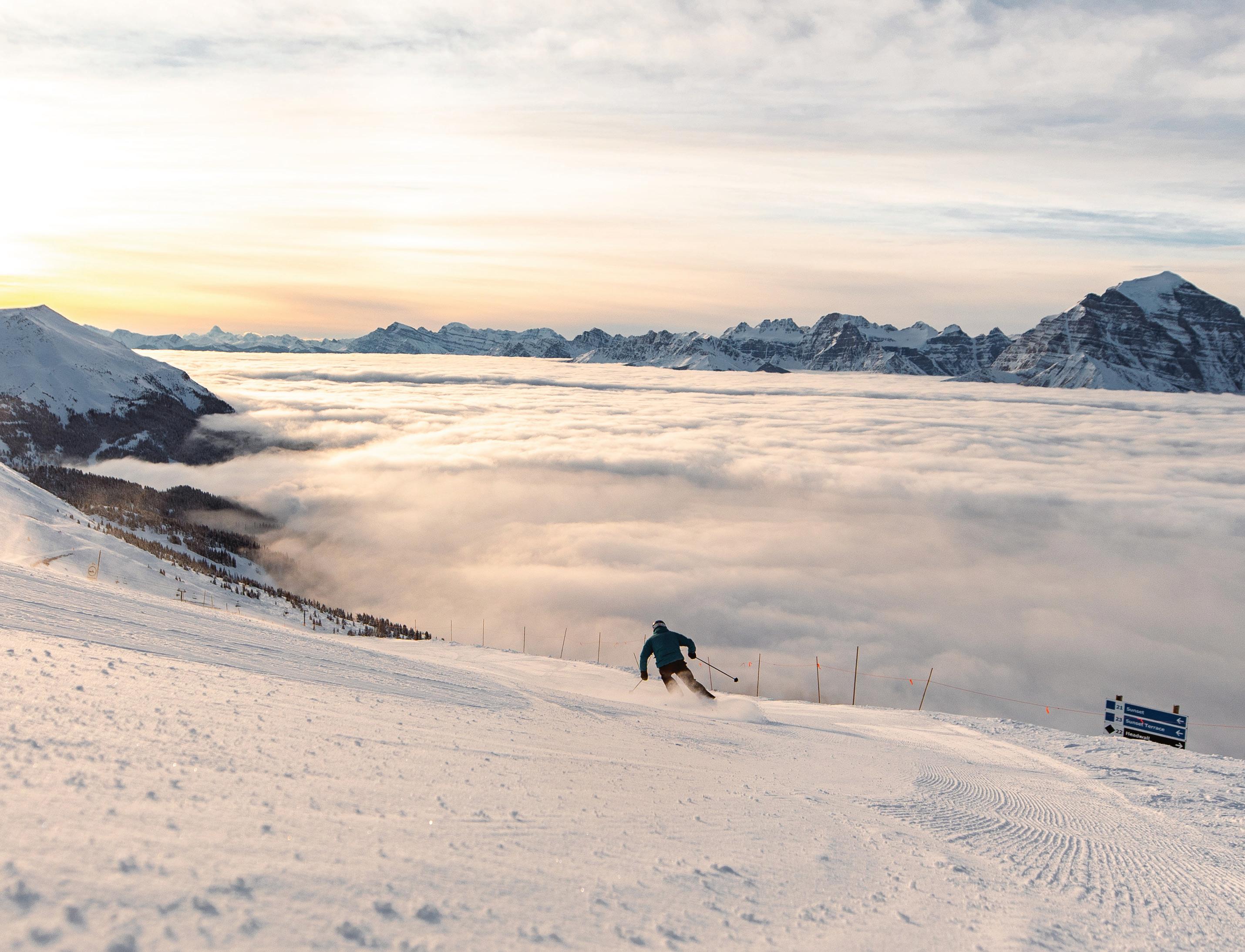
5 minute read
Ski hills wrestle with surge in users
DOWNHILL SKIING FOR MENTAL HEALTH FACES UPHILL BATTLE
Ski hills provide lots of space for exercise, which can contribute to improved mental health. PHOTO: PHILIP FORSEY and LAKE LOUISE SKI RESORT
CHLOE CHAPDELAINE cchapdelaine@cjournal.ca
To relieve pandemic stress, many Albertans are using the outdoors to exercise. This, paired with travel restrictions, has meant Alberta ski hills are booming. However, that’s also creating public health problems, despite safety measures to stop the spread.
The Centres for Disease Control and Prevention says “it is natural to feel stress, anxiety, grief, and worry during the COVID-19 pandemic,” and that one of the most important ways to reduce stress is by taking care of your body, which includes exercise.
That’s because physical activity can make you feel better, function better and even sleep better. In fact, it only takes one session of moderate to vigorous physical activity to reduce anxiety. My Health Alberta, and the Canadian Mental Health Association are just some of the groups that encourage exercise for mental health upkeep.
Because of public health orders closing gyms and fitness studios, finding a place to exercise can be difficult.
As a result, Dr. Kelly Burak,a physician and professor of medicine at University of Calgary, says having outdoor facilities for mental health open right now is “very important, and this is the balancing act that we have to try to find.”
Ski hills are one of the few facilities that allow physical activity and have continually remained open to the public in Alberta, alongside other outdoor facilities such as skating rinks and parks. “It’s such a good thing for your mental health just to be able to come out and ski and get some activity and be outside instead of being inside, which is what a lot of this year has been so far,” says Patrick Hoffman, multimedia coordinator at Banff Sunshine Village.
Aaryn Secker, associate director of education and health promotion at the Canadian Mental Health Association Kelowna branch says, “We know that fresh air, sunlight, and physical activity are good for our mental health, so I genuinely commend the ski hills for thinking about the role they play in their communities and also for their staff.”
Dan Markham, director of communications at Lake Louise Ski Resort, adds, “The people are just really happy that the resorts are open and will do whatever it takes to stay that way.”
Normally, international guests make up just over 10 per cent of those resorts’ traffic. Because of the COVID-19 pandemic, many people from out-of-country haven’t been able to enter Canada. Indeed, air traffic arriving in Calgary and Edmonton
as of November 2020 is down 79.5 per cent. That’s impacted the Canadian ski industry.
However, Markham says, “Despite losing the international market, the regional market has actually grown in volume, so we’ve made up for what we may have lost in the international traffic.”
As the ski hills continue to fill with regional traffic, implementing safety protocols to keep our community safe is very important, notes Secker.
As an example, in March 2020, Burak says he attended a curling bonspiel alongside 73 other healthcare workers and physicians that resulted in an outbreak of COVID-19.
This incident gave insight on how infective COVID-19 is, and why it’s important for indoor masking and other safety measures to be taken wherever people are congregating.
“We’re realizing that ventilation is an important factor in this, so I’m all for outdoor activities and sports. But, you have to be careful when you’re then following that with something indoors like dining, eating, sharing close proximity with others, where you’re not wearing a mask,” he says. “If you’re outdoors where the air is moving, there’s definitely less risk.”
“Unfortunately this is going to be very important for the next little while as we try and prevent the spread of variants which are even more infectious, and until we have vaccines in large numbers of people, that risk is going to be there,” he adds.
Ski resorts have already taken measures to reduce the “party culture” and stop public gatherings, such as special events that encourage crowds, but this isn’t an absolute fix.
Various practices and protocols have been put in place at the ski hills, such as mandatory mask wearing when at ski lifts and around the lodges. Tents have also been added to provide additional space, along with the addition of heated outdoor bathrooms, reduced capacity in the lodges, and more.
Other things changed for individual safety includes allowing people to take the ski lifts by themselves for social distancing. There has also been increased signage to support these and ensure people understand the changes.
Nevertheless, this hasn’t stopped outbreaks from happening, with ski hills in British Columbia and Alberta being hit by COVID-19 .
In November 2020, 19 people tested positive for COVID-19 as a result of an outbreak at Lake Louise Ski Resort and in British Columbia there were 76 cases related to an outbreak linked to Big White ski resort.
“If something doesn’t go the way you wanted it to or you see some room for improvement, try to use it as a learning opportunity and coach and mentor staff,” says Secker, who encourages not only upholding safe practices, but continuing to learn from experiences to better the workplace.
“We work with the other ski resorts to make sure that we’re learning from each other,” adds Markham, in response to how ski hills are dealing with heightened tensions.
“It’s a little challenging for some folks to begin with, but almost everyone has seemed to have fully embraced [protective protocols] knowing that they have to follow the rules if they want to make sure that the resorts stay open,” says Markham.
> Dr. Kelly Burak











